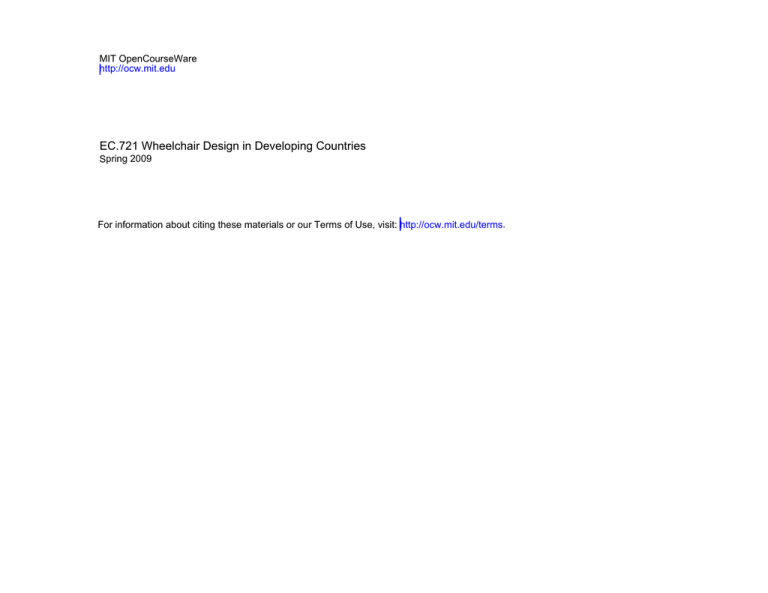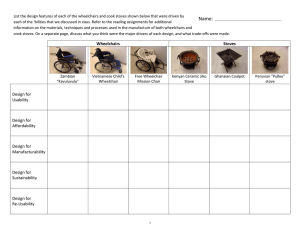EC.721 Wheelchair Design in Developing Countries
advertisement

MIT OpenCourseWare http://ocw.mit.edu EC.721 Wheelchair Design in Developing Countries Spring 2009 For information about citing these materials or our Terms of Use, visit: http://ocw.mit.edu/terms. FITTING A WHEELCHAIR, BIOMECHANICS, AND DESIGN Photo removed due to copyright restrictions. Source: http://doitfoundation.org/brasilito082305.htm Figure by MIT OpenCourseWare. Figure by MIT OpenCourseWare. February 24, 2009 Figure by MIT OpenCourseWare. 2 CORRECT FITTING OF A WHEELCHAIR Complications from improper fitting Sitting habits • • Able bodied person – long period of sitting usually 1-2 hours, shifting weight all the time Disabled person may sit for 3 to 10 hours per day without repositioning Complications due to poor posture • • • • • Photo removed due to copyright restrictions. Source: http://doitfoundation.org/brasilito082305.htm Contractions and deformities Tissue breakdown Reduced performance and tolerance Urinary and respiratory infection Fatigue and discomfort Free Wheelchair Mission Chair (www.doitfoundation.org) February 24, 2009 3 CORRECT FITTING OF A WHEELCHAIR Correct anatomical and wheelchair positions • • 100 o o 105 90 Want to distribute weight over butt and thighs Only want 1.25cm clearance between butt and frame o Correct body position 10o to 15o 10o 1.25cm? 20o Correct wheelchair position Figure by MIT OpenCourseWare. Figure by MIT OpenCourseWare. After Mayall, 1995. 4 February 24, 2009 CORRECT FITTING OF A WHEELCHAIR Considerations during assessment Wheelchair Foundation in Tanzania Considerations during prescription • • • • • • • • • • • • • • • • • Tanzania Big Game Safari: •Largest donator in Tanzania, giving away nearly 7,000 chairs so far. Diagnosis and prognosis Age Communication status Cognitive function Perceptual function Physical ability Level of independence in activities during daily living Transfer ability and modality Mobility (ambulation and wheelchair mobility) Body weight Sensory status Presence of edema Leisure interests Transportation to and from home Roughness of usage Time spent in wheelchair daily Financial resources of patient •Said Wheelchair Foundation will give a chair to anyone who seems to need one – a loose requirement that may include people who are crawling on the ground to people who may walk with a crutch. •Admitted they get so many chairs every year that after the first few hundred have been distributed, it is very difficult to find genuinely disabled people to whom they can give them. Monduli Rehab Center: •Criticized the WC Foundation and said wheelchairs should not be given out like candy. •Because the village terrain is so rough, people should be encouraged to walk with crutches or braces, and WCs should be a last resort. February 24, 2009 List from (Mayall, 1995) 5 CORRECT FITTING OF A WHEELCHAIR Cushioning and positioning Pressure Sores (Close eyes if squeamish) Tuberosities Pelvis positioning with a pre-ischial bar. Pelvis positioning with contoured firm seat and back. Pelvis positioning without a pre-ischial bar. Pelvis positioning with a sling seat and back. Photos removed due to copyright restrictions. February 24, 2009 Figure by MIT OpenCourseWare. After Mayall, 1995. 6 WHEELCHAIR PROPULSION Photos removed due to copyright restrictions. First US wheelchair patent A.P. Blunt, et. all., 1869 •Wheelchair propulsion 2-10% efficient (Woude et al, 1986, 1998) •Optimal human chemical-mechanical whole body efficiency ~ 25% (Mark’s STD Handbook, 1978) •Occurs at ½ max muscle force and ¼ max muscle speed •Optimal efficiency and max power output do not occur together → Engage more muscles for more power Determine best system → Wheelchair propulsion project UROP: Mario Bollini •Determine the upper body motion that yields highest sustainable power at highest efficiency to deterministically design a wheelchair drive system February 24, 2009 7 WHEELCHAIR PROPULSION RESEARCH Previous work: Power output measured from different drive systems Conventional chair Pout = 26.5W Lever-powered tricycle (van der Linden, et al, 1996) Pout = 39.3W Figure by MIT OpenCourseWare. (van der Woude, et al, 1997) Courtesy of Lucas van der Woude. Used with permission. Motivation: To deterministically design a drive system for long and short distance travel, the maximum available efficient power should dictate the design η Phuman = η Thuman ω human = Pout = Fresist Vdevice = Fresist R wheel ω wheel TBD ωwheel = Gear Ratio ωhuman tune through design dictated by environment calculated February 24, 2009 8 WHEELCHAIR PROPULSION RESEARCH Upper body biomechanics data Fifth-percentile arm strength (N) exerted by sitting men (1) (2) Elbow flexion (deg) 180 150 120 90 60 (3) Pull (4) Push (5) Up (6) Down (7) In Out Left Right Left Right Left Right Left Right Left Right Left Right 222 187 151 142 116 231 249 187 165 107 187 133 116 98 96 222 187 160 160 151 40 67 76 76 67 62 80 107 89 89 58 80 93 93 80 76 89 116 116 89 58 67 89 71 76 89 89 98 80 89 36 36 45 45 53 62 67 67 71 71 Figure by MIT OpenCourseWare. (Shigley, Mischke, 1996) Figure by MIT OpenCourseWare. Single arm energy output T (Nm) F 56 F 48.3 27J/stroke* 2π/3 59.1 Figure by MIT OpenCourseWare. θ (rad) 5π/6 35J/stroke 2π/3 Figure by MIT OpenCourseWare. θ (rad) 5π/6 Opposed handrim-wheel rotation Conventional wheelchair propulsion *2% 76.3 T (Nm) error from van der Linden, et al, 1996 February 24, 2009 9 WHEELCHAIR PROPULSION RESEARCH Single arm energy output T (Nm) F 75.6 pull 79.1 73J/cycle! 71.6 40J/stroke push 33J/stroke π 5π/6 56 θ (rad) 5π/6 Rowing-motion propulsion Figure by MIT OpenCourseWare. Additional questions • • • What unidentified upper body motions can give high power output How different disabilities affect range of motion What type of resistance forces will be encountered depending on the environment February 24, 2009 10 LFC DEVELOPMENT Variable speeds through a fixed geartrain L Wheel projection L Chainring RW DFW DCR Hub Low Gear High Gear Geartrain performance Difference between chair velocity (VChair) and hand velocity (VHand) 11 VChair DCR RW = VHand DFW L February 24, 2009 LFC DEVELOPMENT Lever sizing Pushing power at peak efficiency, young male: 19.6W @ 51N and 0.38m/s Max pushing force at slow speed (both hands), 50% male: 356N ηPIn = POut ⇒ ηPHuman = ηFHandVHand = PDrag + PRolling + PGravity Power balance at peak efficiency: 1 ηFHandVHand = CD ρ air A(VChair )3 + mg (VChair )[µ cosθ + sin θ ] Lever length (m) for 36T chainring and 20T freewheel Lever length (m) for 36T chainring and 20T freewheel 1.97-2.19 1.12 1.53-1.75 0.98 1.31-1.53 0.84 1.09-1.31 0.87-1.09 0.70 Lever length (m) 0.56 0.66-0.87 0.42 0.44-0.66 0.28 1.12-1.26 0.98-1.12 0.84-0.98 0.70-0.84 0.56-0.70 0.42-0.56 0.28-0.42 0.14-0.28 0.00-0.14 0.14 0.22-0.44 30 15 0 Coeff of rolling resistance 0.43 Coeff of rolling resistance 0.31 0.25 0.19 0.13 0.00 0.00-0.22 0.01 0.11 0.10 0.08 0.07 0.05 0.04 0.02 1.26 1.75-1.97 0.37 Climbing angle (deg) 0.00 0.01 4.00 8.00 2.19 1.97 1.75 1.53 1.31 Lever 1.09 0.87 length (m) 0.66 0.44 0.22 0.00 0.07 Force balance at peak force: FRe sist 2 = FRolling + FGravity = mg [µ cos θ + sin θ ] Climbing angle (deg) February 24, 2009 12 LFC DEVELOPMENT Off-road testing θ = 17.6° February 24, 2009 13 POWERED TRICYCLE CALCULATIONS Courtesy of Kien Tuong Private Enterprise. Used with permission. 14 February 24, 2009 SOLAR ENERGY DISTRIBUTION Map by Hugo Ahlenius, UNEP/GRID-Arendal. Courtesy of UNEP / Grid-Arendal. http://maps.grida.no/go/graphic/natural-resource-solar-power-potential February 24, 2009 15 DESIGN FOR HUMAN USE Safety factors Uncertainties in strength Uncertainties in Loading σp = σy/ns Fp = Fy/nL Where σp = permissible stress, σy = yield strength, ns = strength factor of safety (typically 1.2 to 1.4) Where Fp = permissible load, Fy = max load, nL = strength factor of safety ntotal = nsnL For machines that can cause injury or death, ntotal is typically 4 to 10+ When choosing a safety factor, consider: •Does the load come from human activity •Does loading come from natural sources (terrain, etc) •What are the consequences of failure? •Is the loading due to a prelaod? •Does the load come from a power source (ex. starting vs. steady torque)? •Does the load come from driven machinery that can change its output? Theory adapted from: Shigley, 1983, Wikipedia, 2007 16 February 24, 2009 EXAMPLE Estimating loading factor in bicycles (drop case) http://www.youtube.com/watch?v=tMmiN6M7GXs&feature=PlayList&p=AE40D5B0BDD7EE 81&playnext=1&index=9 February 24, 2009 17 EXAMPLE Estimating stress in wheelchair axle during tip-over Axle (la = 17mm, da = 16.4mm) Load = 670N Frame Wheel (dw = 660mm) Length to chair center (lf = 203mm) θ = tipping angle FReaction February 24, 2009 18 EXAMPLE Stress in cantilevered Cannondale front shock Photo removed due to copyright restrictions. February 24, 2009 19 HOMEWORK • Reading from Positioning in a Wheelchair • Have first group meeting, define Functional Requirements and project scope, and send to Mentors and Community Partners for Review • Pick first presentation day (March 3rd, 7-8:30pm???) will present strategies then February 24, 2009 20 CLASS ACTIVITY Measuring human power output Next class: Meet in lab Break into teams of 4 to 5, get a mobility aid from office, and go to tunnels in basement Tasks: • • • • Measure the rolling resistance of your team’s mobility aid and calculate the coefficient of rolling friction Measure your MAX mechanical power output on a flat surface for each person in the group (must travel at least 50 feet). Can use rolling start to negate transient effects. Estimate the angle of one of the tunnel ramps (you can do this mathematically and/or experimentally – don’t just eyeball it) Measure each group member’s mechanical power out while going up a ramp. (Note: one wheelchair team should go up backwards) February 24, 2009 21






